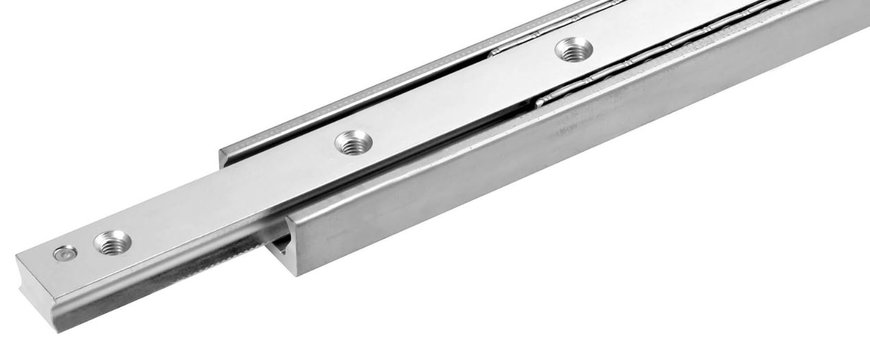Folded or Extruded Steel Rail: Choose The Right Rail For the Job
When it comes to adding linear motion to a fixture, designers have to take a close look at the motion system’s rail construction.

Linear guides and telescopic linear guides are typically made from two types of rail: folded rail — often called formed rail — and extruded rail. Some applications call for an extruded rail system while others are better suited for folded rail. As you determine which type of rail construction is right for your application, be sure to consider the following factors:
- Your load handling requirements
- Your extension requirements
- Your expected cycling frequency
- The operating environment
- Deflections
- Lifetime
- Cost
With these factors in mind, it’s important to understand the construction and characteristics of each type of rail system:
Folded, or formed, steel rail can be desirable for low-load or low-cycle applications, or both. The rails get their shape from rolled steel, and they consist of two-to-four interior forms nested into an outer “C”-shaped form. Load capacity for a given form generally does not change with length, and if it does, it is a minimal increase. They also lack stiffness at load, resulting in higher deflection. Because folded rail is easier to manufacture and lacks the hardened raceways of extruded rail, it is less expensive. However, for applications with loads less than 200 pounds and less than eight cycles in an hour at or near rated capacity, folded rail can be very cost-effective.
Extruded rail is intended for high load capacities, reduced deflection, moderate-to-high cycling and a long service life. Because the steel is formed by extrusion, these rails offer a large cross section to give them a sturdier profile to handle heavy loads with less deflections. When telescoped, they can provide long extensions of 100 percent — even 150 percent — with the ball cage and sliders oriented back-to-back or top-to-bottom. Induction hardening brings out the tough material properties of steel, producing a thick zone around the raceway at the maximum point of stress beneath the rail’s surface. In fact, the resulting surface hardness exceeds the hardness of the base metal. That means it can offer a longer lifetime than folded rail under the same operating conditions. Induction hardened rails can achieve lifetimes ranging from thousands to hundreds of thousands of kilometers of travel.
Get the Most From Your Rail System
Rollon has a wide range of linear rail guides plus telescoping systems available with a choice of folded or extruded rail construction. Standard and custom products can meet various load capacities, extraction lengths and price points. And extruded systems can offer induction hardened raceways and resistance to shock and vibration. By understanding the benefits and drawbacks of each type of rail construction as they pertain to your design criteria, you’ll get a cost-effective system that satisfies your needs.
www.rollon.com

